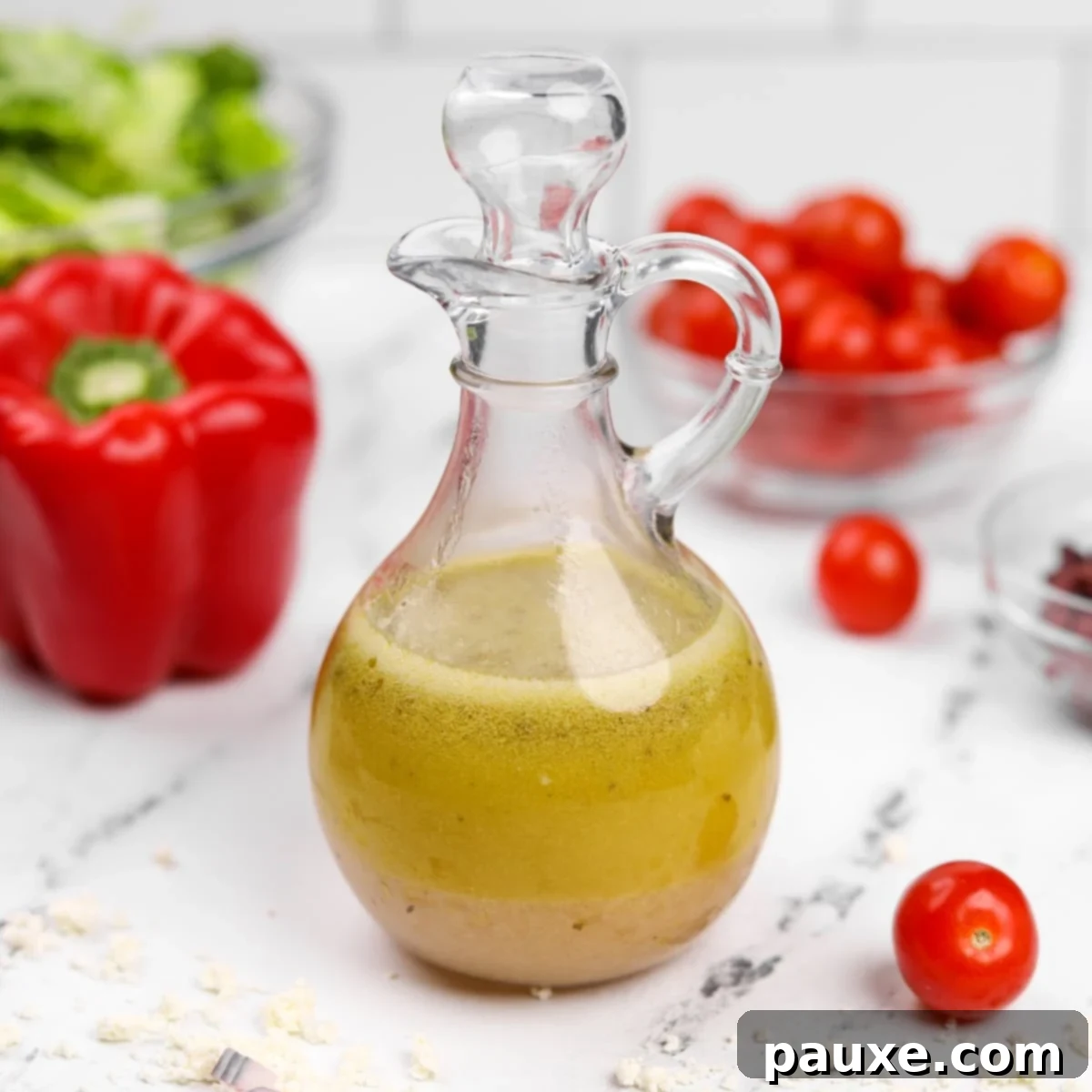This effortless recipe for Homemade Greek Vinaigrette serves as the perfect gateway to crafting your own salad dressings. Featuring a harmonious blend of premium extra virgin olive oil, tangy red wine vinegar, a touch of natural honey, and bright lemon juice, this vibrant Greek dressing promises to elevate an array of dishes. It’s an ideal complement to crisp green salads, hearty pasta salads, succulent roasted vegetables, and much more, infusing every bite with authentic Mediterranean flavor.
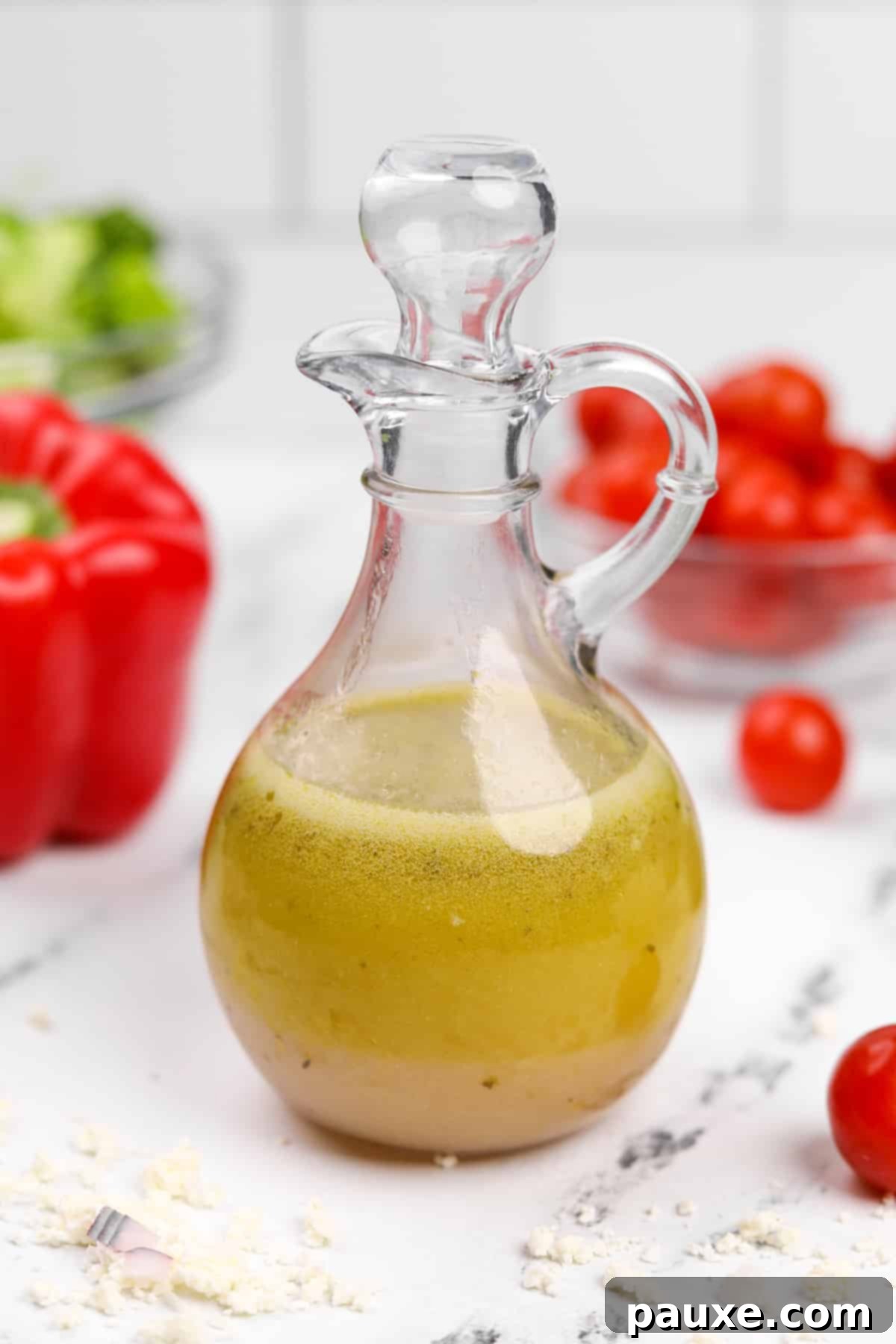
There’s an undeniable superiority to the fresh, vibrant taste of homemade creations. This sentiment rings especially true for salad dressings, which are frequently laden with industrial vegetable oils, artificial emulsifiers, and synthetic preservatives when purchased from grocery store shelves. Opting for a homemade Greek vinaigrette ensures you control every ingredient, prioritizing health and unparalleled taste.
While many of us enjoy the convenience of store-bought ranch or a classic Olive Garden dressing, certain culinary moments call for something a little more refined and bursting with natural goodness. This Greek dressing recipe, often referred to as Greek vinaigrette, is remarkably simple to prepare yet presents an impressively sophisticated flavor profile to your guests. Crafted from readily available, wholesome ingredients, it comes together in under 5 minutes, making gourmet dining accessible any day of the week!
Unleash the Versatility: Diverse Ways to Use Greek Salad Dressing
Beyond its traditional role in a classic Greek salad, this versatile homemade vinaigrette can transform a multitude of dishes. Its bright, tangy, and aromatic character makes it an indispensable addition to your culinary repertoire. Explore these exciting applications:
- Classic Greek Salad (or Green Salad): The quintessential pairing! Drizzle generously over a mix of crisp lettuce, ripe tomatoes, cucumbers, red onion, Kalamata olives, and feta cheese for an authentic Mediterranean experience. It also enlivens any simple green salad.
- As a Marinade: Its acidic components tenderize meats, while the olive oil and herbs infuse incredible flavor. Perfect for marinating chicken, lamb, fish, or even firm tofu before grilling, baking, or pan-searing. Let proteins soak for at least 30 minutes, or ideally several hours for deeper flavor.
- Pasta Salads: Forget heavy, creamy dressings. This Greek vinaigrette adds a refreshing zest to cold pasta salads. Toss with cooked pasta, cherry tomatoes, bell peppers, cucumbers, red onion, and crumbled feta for a light and satisfying meal.
- Quinoa Salads: Elevate your grain bowls! Mix with cooled quinoa, chopped fresh vegetables, chickpeas, and a sprinkle of fresh herbs for a nutritious and flavor-packed vegetarian option.
- Drizzled on Roasted Vegetables: Transform ordinary roasted veggies into a gourmet side dish. Toss potatoes, zucchini, bell peppers, eggplant, or broccoli with the dressing before roasting, or simply drizzle it over them once they come out of the oven for a burst of fresh flavor.
- Dipping with Crusty Bread: Serve it alongside a warm, crusty baguette or pita bread for an irresistible appetizer. It’s a delightful way to savor the rich olive oil and aromatic herbs.
- Grain Bowls & Buddha Bowls: A fantastic finishing touch for any wholesome bowl featuring grains, proteins, and fresh or roasted vegetables.
- Potato Salad Alternative: For a lighter, tangier potato salad, swap mayonnaise for this Greek vinaigrette. It’s surprisingly delicious!
- Grilled Halloumi or Feta: Drizzle over grilled slices of halloumi or baked feta for an appetizer that will impress.
The possibilities are truly endless once you discover the vibrant taste this homemade dressing brings to your table.
Essential Ingredients for a Captivating Greek Vinaigrette
Crafting a truly exceptional Greek vinaigrette starts with selecting quality ingredients. Each component plays a vital role in building the dressing’s characteristic tangy, savory, and subtly sweet profile. Here’s a detailed look at what you’ll need:
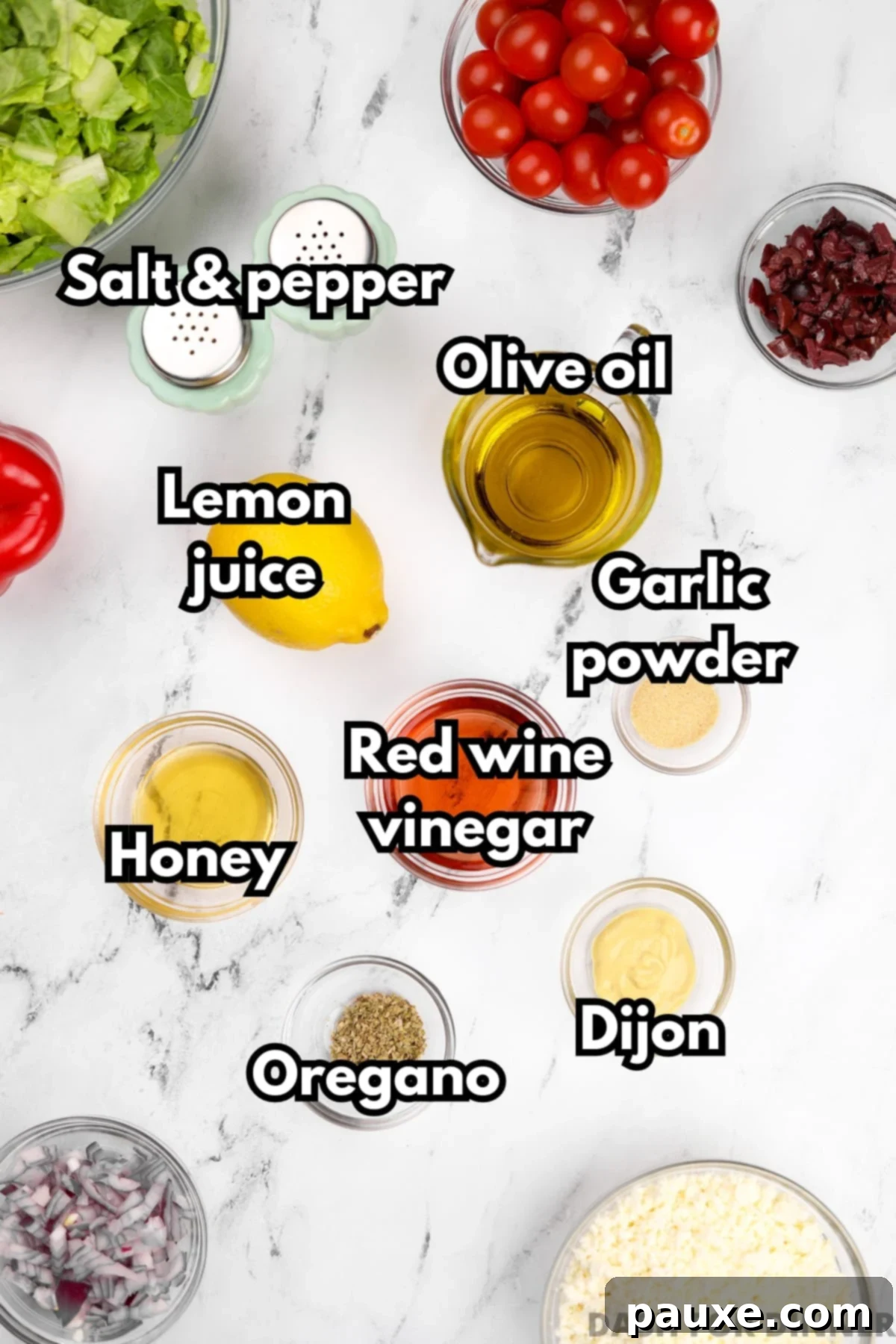
- Extra Virgin Olive Oil: The cornerstone of any great Mediterranean dressing. Invest in a good quality extra-virgin olive oil that you genuinely enjoy the flavor of. Its rich, fruity notes form the luxurious base for this vinaigrette, contributing healthy monounsaturated fats and a distinctive depth.
- Red Wine Vinegar: This is crucial for providing the signature bright acidity and pungent flavor that perfectly complements Mediterranean cuisine. Its robust character balances the richness of the olive oil and honey.
- Honey: Adds a beautiful, subtle sweetness that beautifully harmonizes with the tang of the vinegar and lemon. It also helps to emulsify the dressing slightly. If you’re seeking a vegan alternative, pure maple syrup works wonderfully as a direct substitute, offering a similar sweetness and consistency.
- Fresh Lemon Juice: You’ll need the juice from one fresh lemon. This provides a burst of citrusy brightness that enhances the overall flavor without being overpowering. Always opt for fresh lemon juice over bottled for superior taste.
- Dijon Mustard: A secret weapon for many homemade dressings! Dijon mustard isn’t just for flavor; it acts as a natural emulsifier, helping the oil and vinegar stay combined and preventing them from separating too quickly. It also adds a subtle, piquant kick.
- Garlic Powder: For convenience and even distribution of flavor, garlic powder (or granulated garlic) is preferred over fresh minced garlic in many vinaigrettes. I personally favor granulated garlic as I find it less prone to clumping, ensuring a smooth dressing.
- Dried Oregano: The quintessential Greek herb. Dried herbs often perform better than fresh herbs in vinaigrettes as their flavor can intensify when rehydrated in the oil and vinegar, imparting a deeper, more pronounced aroma.
- Salt and Black Pepper: Essential for seasoning. Start with ¼ teaspoon of each, then taste and adjust according to your preference. These enhance all the other flavors, bringing the dressing to life.
For precise measurements and a comprehensive ingredient list, please refer to the detailed recipe card at the bottom of this page.
Crafting Your Greek Vinaigrette: A Simple Guide
Preparing this homemade Greek salad dressing is incredibly straightforward. You’ll likely wonder why you ever opted for store-bought versions once you experience how quick and easy it is to make your own.
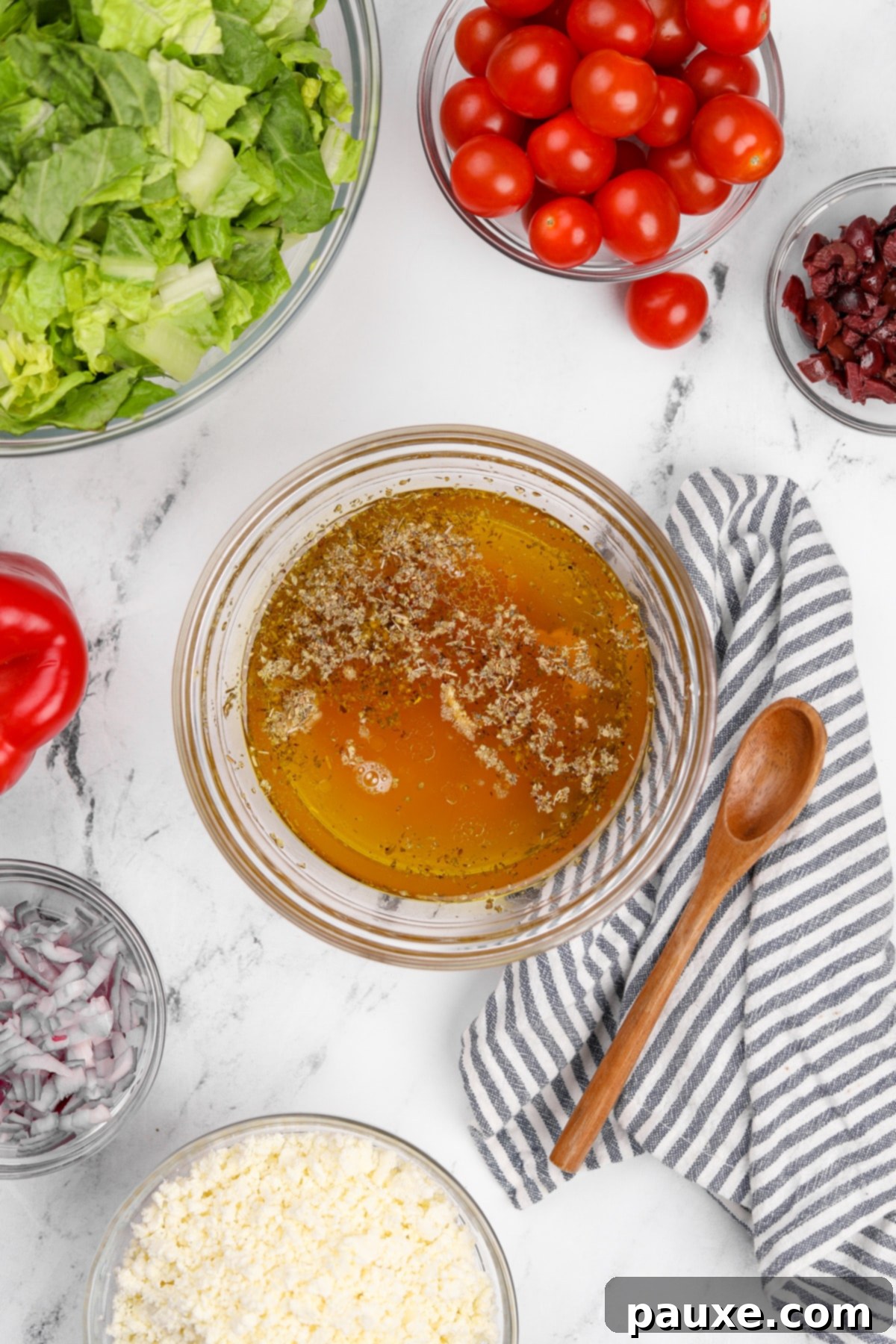
- Combine Ingredients: Gather all the specified dressing ingredients and add them to a small mixing bowl. Precision in measurement ensures a balanced flavor profile.
- ½ cup extra virgin olive oil
- 3 tablespoons red wine vinegar
- 1 lemon, juiced (yielding approximately 2-4 tablespoons)
- 1 tablespoon honey (optional, adjust to taste)
- 1 ½ teaspoons Dijon mustard
- 1 teaspoon dried oregano
- ½ teaspoon garlic powder (or granulated garlic)
- ¼ teaspoon ground black pepper
- ¼ teaspoon salt
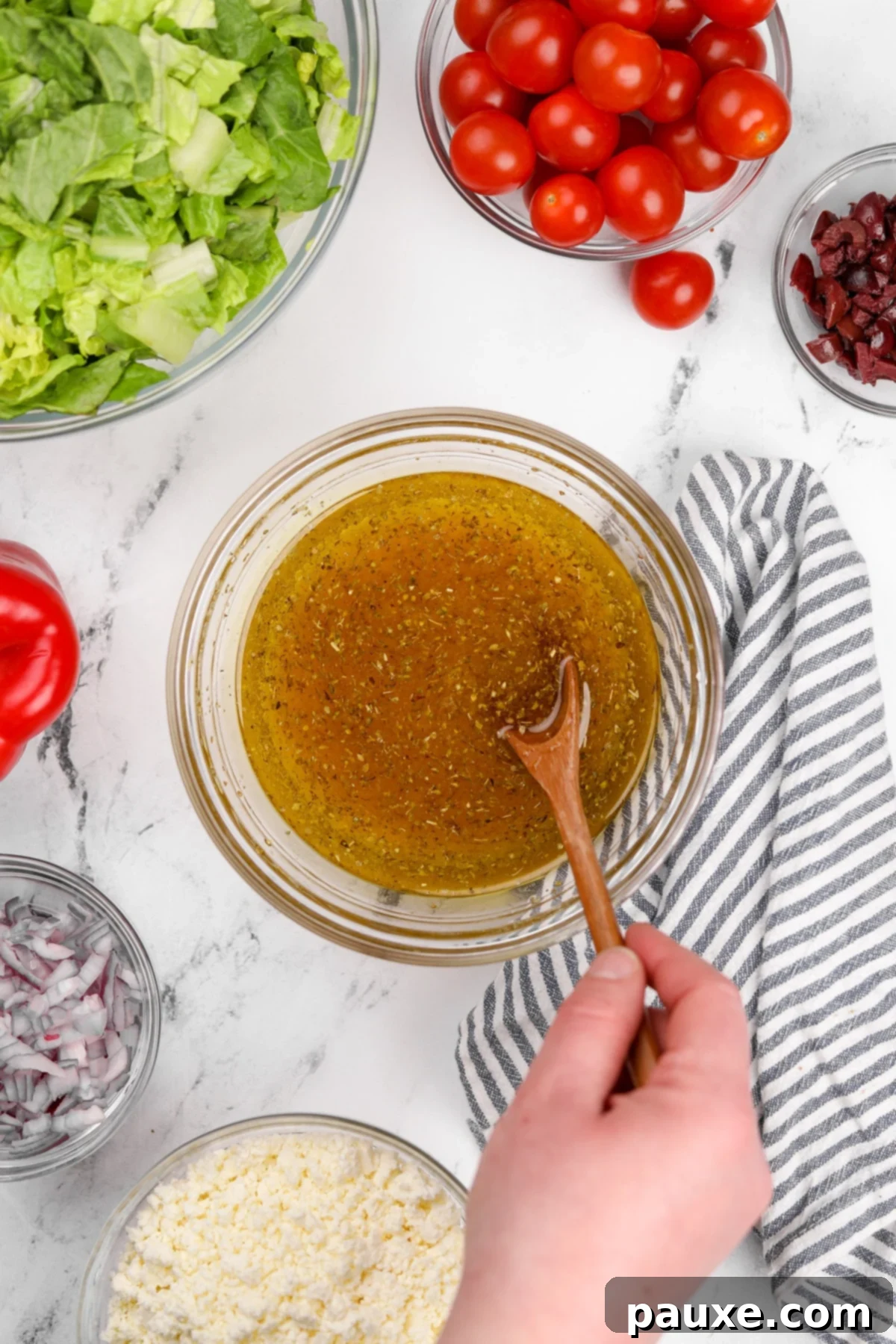
- Whisk Thoroughly: Using a whisk, stir all the ingredients together vigorously. Continue whisking until the oil and vinegar are well combined and the dressing appears slightly emulsified and uniform in consistency. This ensures all flavors are evenly distributed.
Chef’s Tip: For optimal flavor melding, especially if you won’t be serving the dressing within the next 1-2 hours, refrigerate it. Chilling allows the flavors to deepen and harmonize beautifully. Remember to bring it to room temperature before serving for the best texture and pourability.
The Effortless Mason Jar Method
For an even quicker and cleaner preparation process, you can make this delicious Greek vinaigrette directly in the container you plan to store it in! This method minimizes cleanup and is perfect for busy schedules.
- Add Ingredients: Carefully pour all the measured ingredients into a mason jar (or a salad dressing cruet) equipped with a tight-fitting lid.
- Shake Vigorously: Secure the lid tightly and give the jar a good, enthusiastic shake for about 30-60 seconds. This action thoroughly combines and emulsifies the dressing, creating a smooth and consistent texture.
- Serve and Savor: Once well-shaken, your Greek vinaigrette is ready to be served. Pour it over your favorite salads or use it as a marinade. Enjoy the fresh, homemade taste!
Pro Tip: Allow your freshly made dressing to rest at room temperature for 15-20 minutes before serving, especially if you’ve just whisked it. This brief resting period helps the flavors to meld and deepen, providing a more cohesive and delicious experience. Just remember to give it another quick shake right before pouring!
Optimal Storage for Your Homemade Greek Dressing
Proper storage is key to maintaining the freshness and quality of your homemade Greek vinaigrette. Follow these guidelines to ensure your dressing stays delicious for as long as possible:
- Container Choice: Always store your dressing in an airtight container, a dedicated salad dressing cruet, or a mason jar with a secure lid. This prevents air exposure, which can degrade flavor and freshness.
- Refrigeration is Essential: Due to the fresh ingredients, especially lemon juice, it is crucial to store the dressing in the refrigerator. It will keep beautifully for 1-2 weeks.
- Serving at Room Temperature: As olive oil is the base, the dressing will naturally become separated and semi-solid when chilled. For the best consistency and pourability, allow the dressing to come to room temperature for 15-20 minutes before serving.
- Quick Softening Method: If you’re short on time and can’t wait for the dressing to warm up naturally, a quick trick is to run hot tap water over the outside of the jar for a minute or two. This will gently warm the oil, helping it to melt and re-liquify. Always shake well before serving after any warming process.
- Shake Before Each Use: Regardless of storage, oil and vinegar-based dressings tend to separate. Always give the container a good shake or stir vigorously just before each use to re-emulsify the ingredients and ensure every serving is perfectly blended.
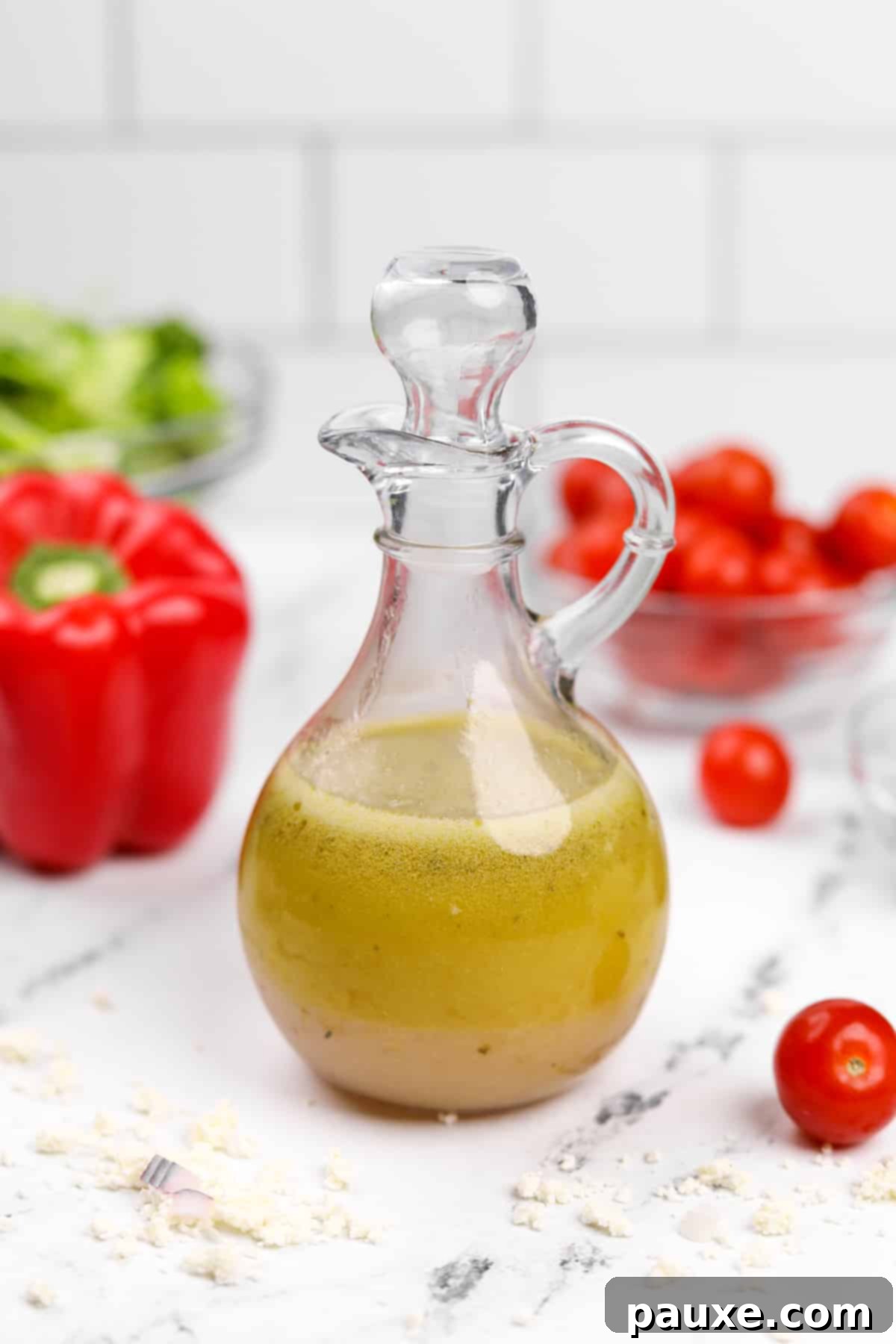
Mastering Your Greek Vinaigrette: Expert Tips for Success
Achieving the perfect homemade Greek vinaigrette is simple with a few expert insights. These tips will help you maximize flavor, optimize consistency, and ensure a delightful experience every time:
- Always Serve at Room Temperature (or Slightly Warmed): This is a crucial tip for olive oil-based dressings. When refrigerated, extra virgin olive oil naturally solidifies and separates, creating a thick, often chunky consistency. While refrigeration is necessary for food safety, letting the dressing sit out on the counter for 15-20 minutes before serving will typically allow the olive oil to soften and become pourable again. For a quicker fix, gently run the outside of the jar under warm tap water until the oil melts. Always give it a good shake before drizzling!
- Prioritize Quality Extra Virgin Olive Oil: The base of your vinaigrette significantly impacts its final flavor. There’s a vast spectrum of olive oils available, but for a homemade dressing where its flavor shines, choose one you genuinely love the taste of. Opt for the best quality extra-virgin olive oil within your budget, as it provides superior flavor, aroma, and beneficial nutrients. Avoid “light” or refined olive oils, which lack the depth and character.
- Acidity is Paramount: A hallmark of any great vinaigrette is the harmonious balance between oil and acid. This Greek version achieves that balance through a combination of robust red wine vinegar and bright fresh lemon juice. If you find yourself without red wine vinegar, you can substitute it with good quality apple cider vinegar or even a milder white wine vinegar in a pinch, though the flavor profile will subtly shift. The key is to maintain a good acid-to-oil ratio (typically 1 part acid to 3 parts oil, adjusted for taste).
- Taste and Adjust: Every palate is different, and the intensity of ingredients can vary. Don’t be afraid to taste your dressing before serving and adjust the seasoning. You might want more salt, a touch more honey for sweetness, or an extra squeeze of lemon juice for added zest. This is where homemade truly shines – customization!
- Let Flavors Marinate: While this dressing is delicious immediately, allowing it to sit for at least 30 minutes, or even a few hours, in the refrigerator before serving can significantly enhance the depth and complexity of its flavors as the herbs and spices infuse into the oil and vinegar.
The Ultimate Companion for Greek Salad and Culinary Adventures
Whether your preference leans towards an authentic, traditional Greek salad bursting with fresh vegetables, or you favor a more Americanized version (like a hearty Greek chopped salad), this vibrant vinaigrette is undeniably the perfect match. Its robust yet refreshing profile complements a wide array of ingredients, making it indispensable for Mediterranean-inspired dishes.
It pairs exquisitely with a variety of fresh, flavorful Mediterranean-inspired ingredients such as:
- Kalamata Olives: Their briny, fruity notes are a classic Greek pairing.
- Feta Cheese: The salty, tangy crumbled feta is elevated by the dressing’s bright acidity.
- Red Onion: Adds a crisp bite and pungent flavor that softens beautifully with the dressing.
- Fresh Garlic: While the recipe uses garlic powder for convenience, fresh minced garlic can be added for an extra pungent kick in specific dishes.
- Eggplant: Roasted or grilled eggplant absorbs the dressing’s flavors wonderfully.
- Goat Cheese: A creamy, tangy alternative to feta, offering a delightful contrast.
- Zucchini: Sliced and grilled or roasted, zucchini is a fresh canvas for this dressing.
- Tomatoes: From cherry tomatoes to ripe Roma, tomatoes truly sing when dressed with this vinaigrette.
- Cucumbers: Crisp and refreshing, they balance the dressing’s richness.
- Bell Peppers: Sweet and crunchy, they add color and texture.
- Artichoke Hearts: Marinated or fresh, they add an earthy tang.
- Chickpeas: A fantastic source of protein and fiber, perfect for making a simple salad more substantial.
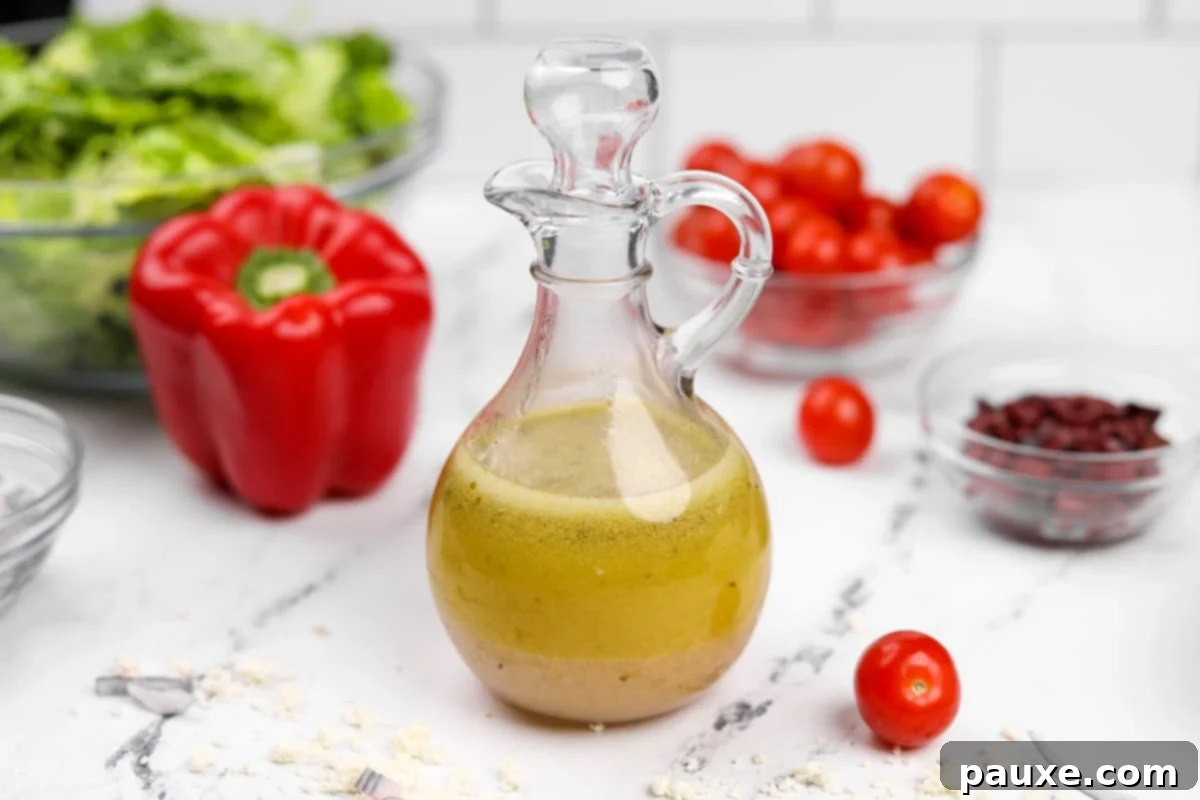
Explore More Delightful Salad Dressing Recipes
If you’ve enjoyed the ease and incredible flavor of this homemade Greek Vinaigrette, you’ll love venturing into other homemade dressing creations. Crafting your own dressings is a rewarding experience that allows for endless customization and ensures fresh, wholesome flavors. Here are a few more fantastic recipes to inspire your culinary journey:
- Leon Dressing (the iconic dressing from the famous La Scala Chopped Salad)
- Everyday Salad Dressing – A versatile staple from Damn Delicious
- Homemade Italian Dressing – Classic flavors from Fresh April Flours
- Creamy Balsamic Dressing – A rich and smooth option from Salt and Lavender
- Champagne Vinaigrette – An elegant and light dressing from Urban Farmie
If you adored this Homemade Greek Vinaigrette recipe, please share your experience! Let me know by leaving a 5-star review in the recipe card below or dropping a comment. You can also tag me on Instagram @dashfordinner to show off your delicious creations!
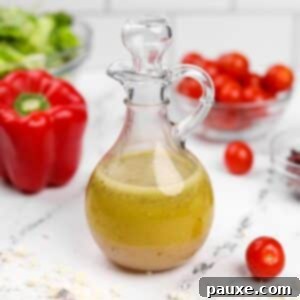
Greek Vinaigrette
This easy recipe for Greek Vinaigrette is ready in less than 5 minutes!
Rating: 5 out of 5 stars (from 1 vote)
Course: Condiments, Salad | Cuisine: Greek, Mediterranean
Prep Time: 5 minutes | Total Time: 5 minutes
Servings: 6 servings | Calories: 179 kcal
Author: Dorothy Bigelow
Equipment
- Salad dressing cruet or mason jar with a lid
Ingredients
- ½ cup extra virgin olive oil
- 3 tablespoons red wine vinegar
- 1 lemon, juiced (approximately 2-4 tablespoons)
- 1 tablespoon honey (optional, for sweetness)
- 1 ½ teaspoons Dijon mustard
- 1 teaspoon dried oregano
- ½ teaspoon garlic powder (or 1 clove, grated, or granulated garlic)
- ¼ teaspoon ground black pepper
- ¼ teaspoon salt
Instructions
- Add all of the ingredients to a mason jar with a lid or a salad dressing cruet.
- Shake very well until all of the ingredients are thoroughly combined and emulsified.
- Serve immediately, or allow the dressing to rest for 15-20 minutes before serving to let the flavors meld. Remember to shake just before serving.
- Store any leftover dressing in the refrigerator for 1-2 weeks. Please note that the olive oil will solidify when chilled.
- Before using refrigerated dressing, allow it to warm on the counter for 15-20 minutes to soften the olive oil. Once softened, shake well and serve.
Notes
*To quickly soften solidified olive oil, allow the dressing to warm on the counter for 15-20 minutes before shaking and serving. Alternatively, you can run the jar under hot tap water to encourage the oil to liquefy faster.
Storage: Store refrigerated for 1-2 weeks.
Nutrition Facts
Serving Size: 2 tablespoons
Calories: 179 kcal | Carbohydrates: 5g | Protein: 0.3g | Fat: 18g | Saturated Fat: 2g | Polyunsaturated Fat: 2g | Monounsaturated Fat: 13g | Sodium: 112mg | Potassium: 40mg | Fiber: 1g | Sugar: 3g | Vitamin A: 11 IU | Vitamin C: 10mg | Calcium: 12mg | Iron: 0.4mg
Please note that some of my blog posts here at Dash for Dinner may contain affiliate links. If you make a purchase through these links, I will receive a small commission at no additional cost to you. Please see my Disclaimer for more information.
